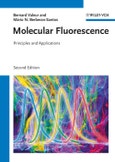This second edition of the well-established bestseller is completely updated and revised with approximately 30 % additional material, including two new chapters on applications, which has seen the most significant developments.
The comprehensive overview written at an introductory level covers fundamental aspects, principles of instrumentation and practical applications, while providing many valuable tips.
For photochemists and photophysicists, physical chemists, molecular physicists, biophysicists, biochemists and biologists, lecturers and students of chemistry, physics, and biology.
The comprehensive overview written at an introductory level covers fundamental aspects, principles of instrumentation and practical applications, while providing many valuable tips.
For photochemists and photophysicists, physical chemists, molecular physicists, biophysicists, biochemists and biologists, lecturers and students of chemistry, physics, and biology.
Table of Contents
INTRODUCTIONWhat Is Luminescence?
A Brief History of Fluorescence and Phosphorescence
Photoluminescence of Organic and Inorganic Species: Fluorescence or Phosphorescence?
Various De-Excitation Processes of Excited Molecules
Fluorescent Probes, Indicators, Labels, and Tracers
Ultimate Temporal and Spatial Resolution: Femtoseconds, Femtoliters, Femtomoles, and Single-Molecule Detection
PART I: PRINCIPLES
ABSORPTION OF ULTRAVIOLET, VISIBLE, AND NEAR-INFRARED RADIATION
Electronic Transitions
Transition Probabilities: The Beer -
Lambert Law, Oscillator Strength
Selection Rules
The Franck -
Condon Principle
Multiphoton Absorption and Harmonic Generation
CHARACTERISTICS OF FLUORESCENCE EMISSION
Radiative and Nonradiative Transitions between Electronic States
Lifetimes and Quantum Yields
Emission and Excitation Spectra
STRUCTURAL EFFECTS ON FLUORESCENCE EMISSION
Effects of the Molecular Structure of Organic Molecules on Their Fluorescence
Fluorescence of Conjugated Polymers (CPs)
Luminescence of Carbon Nanostructures: Fullerenes, Nanotubes, and Carbon Dots
Luminescence of Metal Compounds, Metal Complexes, and Metal Clusters
Luminescence of Semiconductor Nanocrystals (Quantum Dots and Quantum Rods)
ENVIRONMENTAL EFFECTS ON FLUORESCENCE EMISSION
Homogeneous and Inhomogeneous Band Broadening - Red-Edge Effects
General Considerations on Solvent Effects
Solvent Relaxation Subsequent to Photoinduced Charge Transfer (PCT)
Theory of Solvatochromic Shifts
Effects of Specific Interactions
Empirical Scales of Solvent Polarity
Viscosity Effects
Fluorescence in Gas Phase: Supersonic Jets
EFFECTS OF INTERMOLECULAR PHOTOPHYSICAL PROCESSES ON FLUORESCENCE
EMISSION
Introduction
Overview of the Intermolecular De-Excitation Processes of Excited Molecules Leading to Fluorescence Quenching
Photoinduced Electron Transfer
Formation of Excimers and Exciplexes
Photoinduced Proton Transfer
FLUORESCENCE POLARIZATION: EMISSION ANISOTROPY
Polarized Light and Photoselection of Absorbing Molecules
Characterization of the Polarization State of Fluorescence (Polarization Ratio and Emission Anisotropy)
Instantaneous and Steady-State Anisotropy
Additivity Law of Anisotropy
Relation between Emission Anisotropy and Angular Distribution of the Emission Transition Moments
Case of Motionless Molecules with Random Orientation
Effect of Rotational Motion
Applications
EXCITATION ENERGY TRANSFER
Introduction
Distinction between Radiative and Nonradiative Transfer
Radiative Energy Transfer
Nonradiative Energy Transfer
Determination of Distances at a Supramolecular Level Using FRET
FRET in Ensembles of Donors and Acceptors
FRET between Like Molecules: Excitation Energy Migration in Assemblies of Chromophores
Overview of Qualitative and Quantitative Applications of FRET
PART II: TECHNIQUES
STEADY-STATE SPECTROFL UOROMETRY
Operating Principles of a Spectrofl uorometer
Correction of Excitation Spectra
Correction of Emission Spectra
Measurement of Fluorescence Quantum Yields
Possible Artifacts in Spectrofl uorometry
Measurement of Steady-State Emission Anisotropy: Polarization Spectra
TIME-RESOLVED FLUORESCENCE TECHNIQUES
Basic Equations of Pulse and Phase-Modulation Fluorimetries
Pulse Fluorimetry
Phase-Modulation Fluorimetry
Artifacts in Time-Resolved Fluorimetry
Data Analysis
Lifetime Standards
Time-Resolved Polarization Measurements
Time-Resolved Fluorescence Spectra
Lifetime-Based Decomposition of Spectra
Comparison between Single-Photon Timing Fluorimetry and Phase-Modulation Fluorimetry
FLUORESCENCE MICROSCOPY
Wide-Field (Conventional), Confocal, and Two-Photon Fluorescence Microscopies
Super-Resolution (Subdiffraction) Techniques
Fluorescence Lifetime Imaging Microscopy (FLIM)
Applications
FLUORESCENCE CORRELATION SPECTROSCOPY AND SINGLE-MOLECULE FLUORESCENCE
SPECTROSCOPY
Fluorescence Correlation Spectroscopy (FCS)
Single-Molecule Fluorescence Spectroscopy
PART III: APPLICATIONS
EVALUATION OF LOCAL PHYSICAL PARAMETERS BY MEANS OF FLUORESCENT PROBES
Fluorescent Probes for Polarity
Estimation of 'Microviscosity', Fluidity, and Molecular Mobility
Temperature
Pressure
CHEMICAL SENSING VIA FLUORESCENCE
Introduction
Various Approaches of Fluorescence Sensing
Fluorescent pH Indicators 412 Transfer (PET)
Design Principles of Fluorescent Molecular Sensors Based on Ion or Molecule Recognition
Fluorescent Molecular Sensors of Metal Ions
Fluorescent Molecular Sensors of Anions
Fluorescent Molecular Sensors of Neutral Molecules
Fluorescence Sensing of Gases
Sensing Devices
Remote Sensing by Fluorescence LIDAR
AUTOFL UORESCENCE AND FLUORESCENCE LABELING IN BIOLOGY AND MEDICINE
Introduction
Natural (Intrinsic) Chromophores and Fluorophores
Fluorescent Proteins (FPs)
Fluorescent Small Molecules
Quantum Dots and Other Luminescent Nanoparticles
Conclusion
MISCELLANEOUS APPLICATIONS
Fluorescent Whitening Agents
Fluorescent Nondestructive Testing
Food Science
Forensics
Counterfeit Detection
Fluorescence in Art
APPENDIX: CHARACTERISTICS OF FLUORESCENT ORGANIC COMPOUNDS
INDEX








